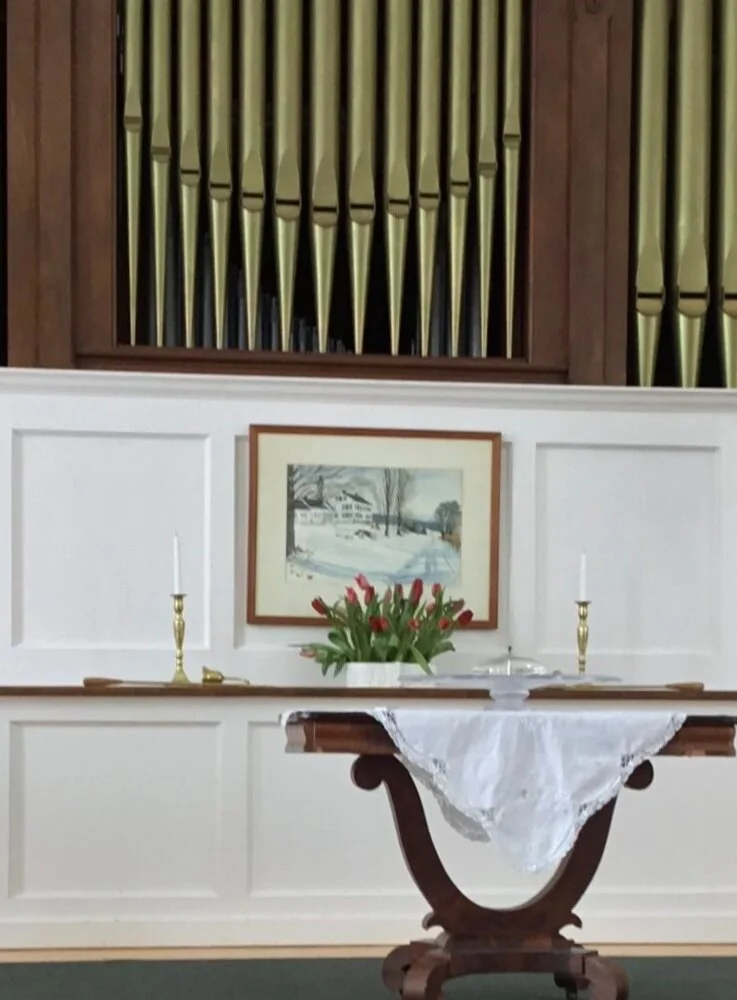History of North Chapel
A Brief Early History of Universalism in Woodstock
Art by Reilly Leaver
In the late 1700ʼs, as was typical in New England, Vermont residents were required to support and attend the established church in their town unless they declared in writing that they belonged to another. In Woodstock, that church was the Congregational Church, which, like most churches of the day, supported the tenets of Calvinism, including the doctrine of predestination and limited salvation.
During this time, English Universalists began arriving in the United States to escape persecution. They believed that God was a loving Creator and that all people would eventually be reconciled with Him in heaven. Their doctrine of hope and love was popular and spread quickly throughout New England and beyond.
In 1786, a dispute between church members in the Congregational church erupted over several issues, including the concept of universal salvation. This dispute continued for several years until, eventually, several influential members, including Benjamin Emmons, Judge William Perry, Captain John Strong, and Dr. Stephen Powers, left to form a new society. In 1789, the first written documentation of a Universalist Society occurred when Israel Keith of Pomfret declared that he was a member of the Universalist Society of Woodstock.
By 1799, the ideas of Universalism had spread widely throughout Woodstock and the surrounding towns and it was decided that the annual Universalist General Convention should be held in Woodstock. The guest speaker at the convention was a young, rising star in Universalism, Hosea Ballou.
Ballouʼs manner and style impressed attendees and, shortly after the convention, Woodstock and Barnard were added to his already extensive preaching circuit. He often preached daily, traveling a circuit, once every two months, from Barnard in the north to Gloucester, Massachusetts in the east and to Worcester County, Massachusetts in the southwest.
In 1803, having been called to settle over the societies of Woodstock, Barnard, Bethel, Hartland, and Bridgewater, Ballou moved from Dana, Massachusetts to Barnard. Woodstock did not have a church building, so services were held at members’ homes and at other locations in town. During his stay in Woodstock, Ballou wrote his most important work, A Treatise on Atonement, which was published in 1805. In 1809, he accepted a call to the Universalist church in Portsmouth, New Hampshire.
The First Settled Minister and the Building of the Church
After Ballouʼs departure, the society hired a number of circuit preachers, when Russell Streeter was called as minister in 1834, little was left of the original Universalist Society. Rev. Streeter, born in 1791 in Chesterfield, New Hampshire and raised as a Baptist, read Ballouʼs Treatise on Atonement at the age of fifteen and embraced the ideas of Universalism. He had begun preaching in New Hampshire and Vermont when he was nineteen and in 1821, at the age of twenty, he founded the First Universalist Society of Portland, Maine.
Immediately upon his arrival in Woodstock, this energetic minister—along with 23 other men—formally organized a new society called the North Universalist Chapel Society. Within a month, he arranged for the purchase of land at 7 Church Street. Less than a year later, on November 18, 1835, the new church was dedicated.
Originally, the property included only the land upon which the church was built. The parsonage at 9 Church Street was purchased in 1877. Then, in 1902, the Billings family, owners of the land extending from the back of the church building to the Ottauquechee River, deeded that land to the church.
Hard Times and Resilience
The Society found itself in a difficult financial situation during the Depression and, by 1933, had no choice but to close the church. The church was opened only on special occasions and there was no settled minister or regular services.
By 1939, the society was forced to sell the parsonage. It was also a pivotal year in what would become the rebirth of the church. That November, a group of women formed the Women’s Social Group. Although the church building was closed, the women agreed that it was important to provide Sunday school for the children. They organized the program and taught the classes and were also important fund-raisers for the church. From paying ten cents a month in dues to organizing bean suppers, plays, and bazaars to selling knives and cookbooks, their financial contributions provided crucial support for the maintenance and upkeep of the building. Eventually, when the church reopened, the group provided a substantial portion of the minister’s salary.
In 1946, Mounir Saʼadah, a history professor originally from Damascus, Syria, was invited to visit the Woodstock Country School in South Woodstock. He spoke about Middle East affairs at the North Chapel and, as a result of his visit, he was offered a position teaching history and philosophy at the school and was called by the North Universalist Chapel Society to serve as its minister. Rev. Saʼadah served in both capacities for 18 years, leaving in 1964 to take a position at The Choate School. During his tenure, the church repurchased the parsonage that had been sold during the Depression.
Major Renovation 2000
Prior to a major renovation project in 2000, the basement of the church was a storage area with dirt floor. A major capital campaign funded construction of the social hall, classrooms and kitchen and bathrooms that benefit both members of the church community and the larger Woodstock community. The construction also included an elevator to provide accessibility to all parts of the building.


